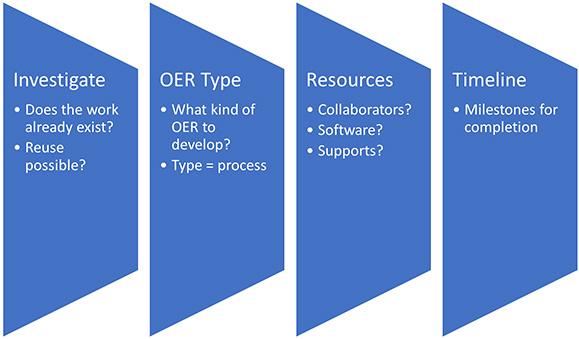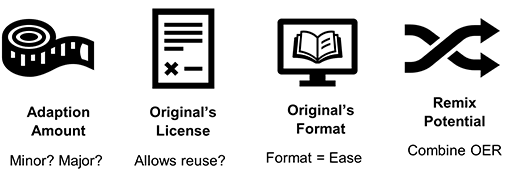Create or modify OERs
Before creating an OER, or modifying an existing one, it is important to understand the fundamentals of open publishing. UM Libraries supports the platform Pressbooks which assists in producing open textbooks and other open texts.
Creation plan checklist
Design considerations
Even if you have not found an existing OER that covers the specific content of interest, you can look to existing OER for ideas about organization and sequencing. You can also incorporate smaller open works like CC-licensed images to support your text.
OER adaption assessment
Tips for authoring a new or remixed work
When writing your resource, remember: make the work accessible and inclusive
Audience
Edited/Remixed work: When editing an existing OER, consider how your audience and learning objectives differ from those of the original work. Your goal should be to bring that work into alignment with your specific context.
Authoring tools
Edited/Remixed work: Depending on the format of the original work, you may be able to do your editing in the document itself - for example, a Word or OpenOffice document can easily be edited using those programs or a web-based alternative like Google Docs. Pressbooks also has features which specialize in adapting existing OER. For example, the import tool allows you to import content from other sources for adapting.
License
Edited/Remixed work: Be aware that the license of the original work impacts how you can adapt and share your adapted version. For example, if the original work used a Share Alike CC license, you must release your work under a compatible license to comply with those terms. Keep in mind that almost all openly licensed work will require that you appropriately credit the original author.
You may not have the time or expertise necessary to develop a more complex OER on your own. Seek collaborators, through community platforms like Rebus or use open pedagogy to get students involved in the process of creating OERs.
Sharing your OER
Because OERs are openly licensed, they can be shared widely, including:
- via UM Learn
- on the Campus Manitoba Pressbooks network
- on a faculty webpage
- via Google Drive
- in an OER repository such as OER Commons, Rebus Community, Teaching Commons or MERLOT
Getting started with Pressbooks
Adapted from Pressbooks (CC BY)
As part of the University of Manitoba, you have access to the Pressbooks Authoring & Editing Platform, through Campus Manitoba’s Pressbooks network.
Using the Pressbooks Authoring & Editing Platform, you can
- adapt existing OER for your classrooms;
- create new material from scratch;
- enrich content with accessible math notation, videos, audio, web annotation, and H5P interactive elements like quizzes and activities.
To start creating, visit the Campus Manitoba Pressbooks network, choose Sign In, Institutional Login, and then University of Manitoba. From here you can use your U of M login to access Pressbooks.
For more technical guidance, visit the Pressbooks User Guide and the Pressbooks FAQ. You can also look through the Pressbooks Directory to find examples. A recorded workshop from UM Libraries is also available.
Pressbooks also holds live training sessions. Visit the PressbooksEDU Training Schedule and register to participate.
Integrate Pressbooks content into UM Learn
Pressbooks Results is a way to integrate your Pressbooks chapters into your UM Learn course, so that students can interact with the content without ever leaving UM Learn. You can even incorporate results from H5P activities in Pressbooks into your gradebook.
You can only use this feature with your own books in Pressbooks; to use it with someone else’s book, clone the book to your own account first.
Using Pressbooks Results
- If you have included H5P activities which you want to be graded, navigate to edit the chapter in which they appear. Scroll down to below the text editing box, where you’ll find a section called LMS Grade Reporting. Check the box beside the activities you want graded.
- In UM Learn, navigate to the module in Content where you’d like the chapter to be. Click Existing Activities, and choose Pressbooks Content Selector. You should be taken to a list of your books, including chapters in Pressbooks. Check the box to choose the section of interest, then scroll down and choose Select Content. Your Pressbooks content is now added!
- If you are using the grading feature for your H5P activities, navigate to the Enter Grades page, under the Assessment menu. Here you can edit the point value of the activities.
More detailed instructions from Pressbooks.
Related tutorials from Pressbooks
Resources
Creating/adapting OERs:
- OS Toolkit: Evaluating OERs
- OS Toolkit: Open Pedagogy
- BCcampus - Adaptation Guide
- Modifying an Open Textbook: What You Need to Know
Getting started with Pressbooks:



